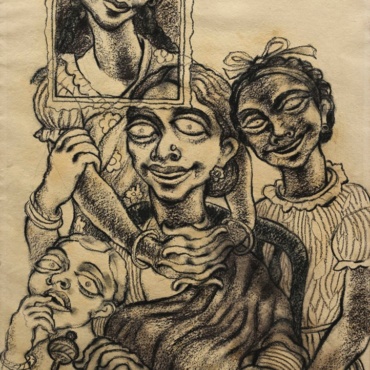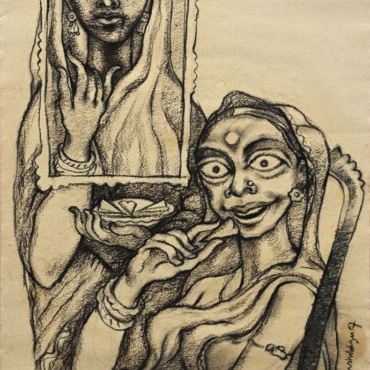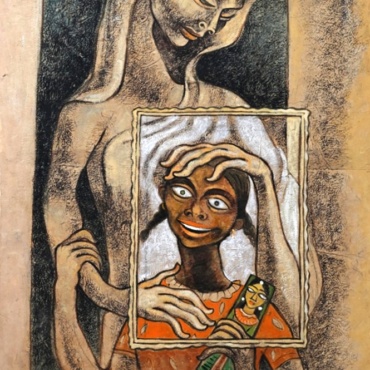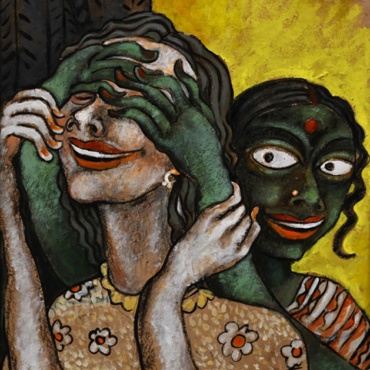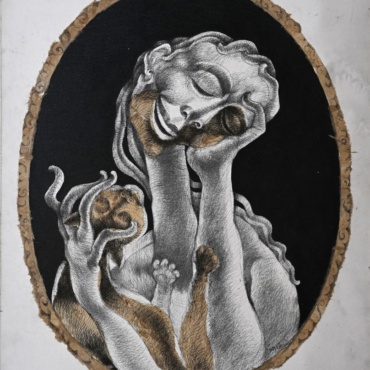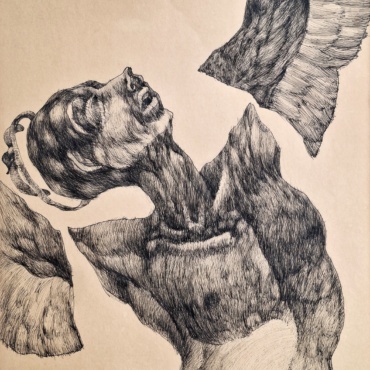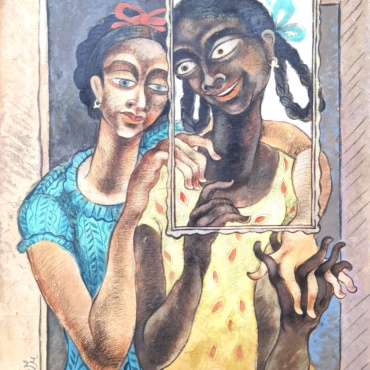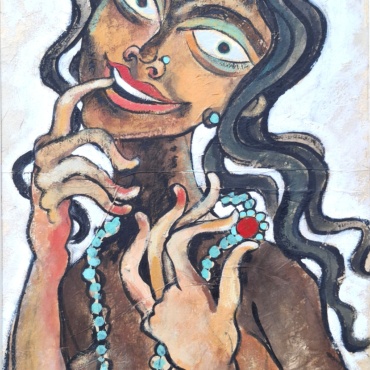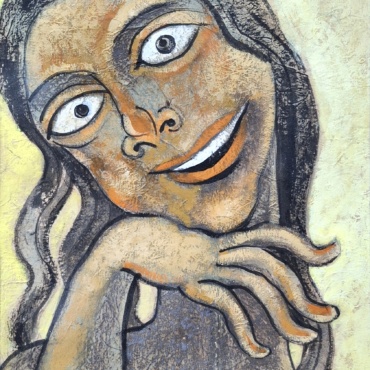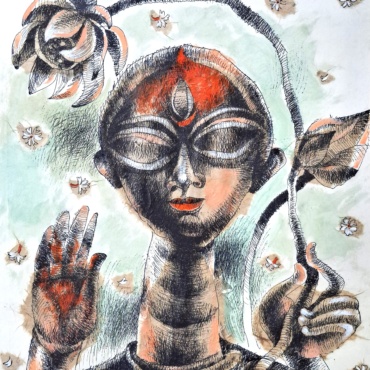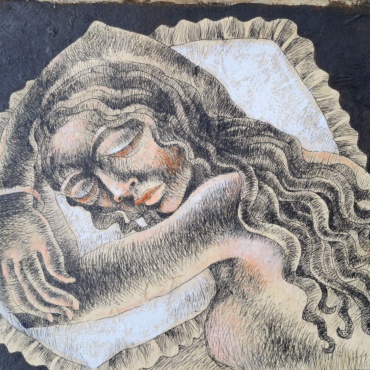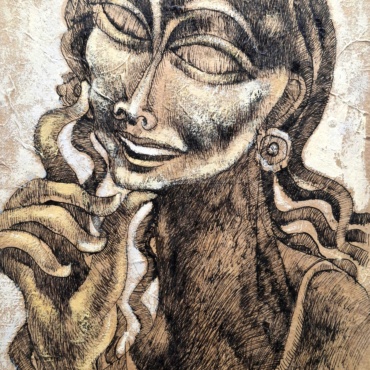A deep melancholy disguised in satire
How may we introduce Sushobhan Adhikary? Together he is an artist, art-critic, researcher and analyst of Tagore’s paintings and writings and ex-curator of the Nandan Museum of Kala Bhavana, Santiniketan. But once we come to know about one of his childhood incidents, that sounds like a story though it is true, one may think that although his identity lies in his diversity, he is primarily an artist.
Let’s have a look at the childhood incident, when he was not even initiated to alphabet he could draw. It was his maternal uncle who taught him to draw. He started learning the alphabets by drawing them with colour. Later he was admitted to school. In fact, the Krishnanagar Collegiate School was the residential building of Manmohan Ghosh who was a bosom friend of Satyendranath, the second elder brother of Rabindranath. In the academic sphere of Bengal, as well as India, Nadia earned a historical importance. Once, known as the cultural hub of the philosophy of logic to the Sanskrit scholars, Nabadwip of Nadia district still enjoys its eminence to the world as ‘Oxford of India’. Regarding Nabadwip, the man whose name comes to our mind primarily is none other than Sri Chaitanya Mahaprabhu.
Another man of repute whose name is closely associated with Krishnanagar, the birthplace of Sushobhan Adhikary, is one of the famous international idol makers of India, Jadunath Pal. Besides, here lived renowned Gopeswar Pal who was most famously known as G. Pal. Once named after the local king, Maharaja Krishna Chandra, this city may boast to be the birth place of men of talent like Pramatha Chowdhury, Amiya Sanyal, Reba Muhuri and others. And how can we forget about D. L. Ray! Anyway, let us get back to the milieu of school of Sushobhan Adhikary (born in the year of 1958). Decorate by Italian Marbel, the building had a vast ground outside the residential area, surrounded by trees. Only its entrance had a plaque with the name of Manmohan Ghosh engraved on it. Since his childhood he started drawing, being encouraged by his mother. But the headmaster of the school was apprehensive about how on earth a little boy of class one could make such skillful drawings! Surely those were done by one of the elders of the family.
At the outset of sixties, West Bengal was an enlightened state in respect of social, political and cultural sphere. In ’61, Bengal as well as the entire country became overwhelmed on the occasion of Tagore’s birth centenary, though all debates and discussions were centered around his poems, songs and other literary creations. But that the poet was simultaneously an artist of international repute was yet to be recognized by national intelligentsia. His brilliance as an artist first came to notice on his 125 birth anniversary when Sushobhan Adhikary was a full grown youth of twenty eight years and was appointed as senior artist in Rabindra Bhavan, Santiniketan.
The river Jalangi flows by Krishnanagar and mingles into the river Ganges. It may seem interesting to the art lovers to know how the life of Sushobhan Adhikary, hailing from Krishnanagar flows into Santiniketan. In his school days, he found Pradip Basu, a friend and nearly contemporary of Ganesh Pyne as his art teacher. Although, prior to this he started copying calender art being driven by his passion for drawing and gradually Sushobhan’s strokes became stronger and they emitted both of his sense of confidence and rhythm. It may be said that he was initiated to anatomy through those drawings. From Pradip Basu, he came to know how to draw still life or how to create the magical illusion of light and shadow by using pencil tone. Till then, Nandalal Bose or Ramkinkar Baij or Benod Behari–they were not known to Sushobhan. He was rather proficient in engineering drawing as a student of science stream. Due to this reason, later on the influence of his training in sculpture became evident in his paintings and that he was a student of science justifies the predominance of logic in his literary works and his tendency to explain in depth with the aid of a very few words.
In spite of strong objection from his family, Sushobhan was driven by the urge of becoming an artist and was championed by someone like his elder sister outside his family circle. It was primarily because of her insistence Sushobhan set off for Kalabhawan to learn art.
The day Sushobhan arrived for his admission, Dinkar Kaushik, the principal of Kalabhawan was absent due to his ill health. So Sushobhan had to visit him at his residence. The moment he appeared before the principal, Sushobhan was severely chided by him as it was the last day for admission as a student. As he came to Kalabhawan to fill in the admission form, at the entrance he found a large crowd around ‘Mill Call’, the sculpture crafted by Ramkinkar. After casting a glace, a camera covered by a while towel was found on a rickshaw which implied that a shooting was going on. As Ritwik Kumar Ghatak and Ramkinkar appeared together, all the ordour came to an end. Partha Pratim Chaudhury, the cameraman drove the camera once placing it on a rickshaw, around the ‘Mill Call.’ As a student Sushobhan understood how to observe a sculpture, i.e. by kinetic movement. Gradually the sapling of his formal education started receiving care and guidance under the tutelage of the renowned teachers of Kalabhawan. Whom should we name! There ware Somnath Hore, Sanat Kar, Ajit Chakraborty, Suhash Roy, Sukhomoy Mitra along with Dinkar Kaushik as principal. The first two years were spent in learning how to do design, ornamental design (Alpona), print, batik, besides drawing.
Ajit Chakraborty wanted Sushobhan to concentrate on sculpture. Somnath Hore wanted him to learn print making. To frailly built Sushobhan, sculpture seemed to be quite laborious and he was not so sure about the availability of equipments of print making post Kalabhawan days. Thus he zeroed in on painting. Perhaps till then he was not aware of the fact that his life had been deterined by two constants–words and strokes. While pursuing his master’s degree in the department of painting he came in touch with the artist, K. G. Subrahmanyan as his teacher and mentor. Another fact is to be noted that, in 1938, during the life time of Rabindranath, the famous Kathakali exponent from South India, Kelu Nair joined the department of dance in Santiniketan as a professor. Sushobhan, the student of Kalabhawan learned Kathakali for two years under his guidance.
Everything in life gets reflected in art. It the spontaneity of his powerful strokes was the outcome of the guidance imparted by K. G. Subrahmanyan, does the rhythm of his personal style not owe to his short-lived training in Kathakali under the tutelage of Kelu Nair?
On one hand, he was recognized as one of the major authors in Bengal and side by side his association with Rabindra Bhawan in the first quarter of his professional life and later with Kalabhawan brought about an excellence in his musing on Rabindranath. And whenever he could manage some spare time in his busy schedule loaded with responsibility he kept himself engaged in painting relentlessly. Hopefully, most of us know that those paintings were exhibited in various galleries of our country. One of his most favourite colours is black. Does that mean that he disfavours orange? No way. He creates the female countenance with his powerful strokes and her emotion finds expression in chiaroscuro produced by the application of cross-hatch in the signature style of Sushobhan. The way he applies unexpected hues (like orange) on the structure he creates brings about an otherworldly elegance. The form of the fingers of his female figures reminds us of the Ajanta paintings. Or do these poses recall the rhythm of Kathakali that Sushobhan tried to master in his student life? But Sushobhan does not admire mere physical beauty, his portrayal of female figures creates an intimacy between the viewers and the particular moment he creates by his painting, it generates a sense of empathy among us. When he was associated with Raindra Bhawan, he remained engrossed with the albums of the Tagore family. Being enwrapped in an age of aristocracy, the very personal cry of distress of some of the characters left him immersed in their desolation. Did his intense study of those albums not leave any mark on his art? Again, when Sushobhan deals with nature in his paintings, the Kopai he depicts renders us melancholic. We regret about the charm of old Kopai after watching his works. If colour serves as the window of expression for Sushobhan, then his strokes are his principal resource, one compliments other. Through his landscapes he shows the primitive, simple nature devoid of the stench of modernity. Simultaneously, he expresses a pathetic irony for those women having unfulfilled desires. Was the irony targeted to one hapless lady? Or the ladies in general? Perhaps, not. As a person, Sushobhan is soft-spoken, and modesty vouches for his inner strength; thus, the mild banter of his painting denotes his silent protest against the social system itself. The title of his current exhibition is ‘A deep melancholy disguised in satire…’





